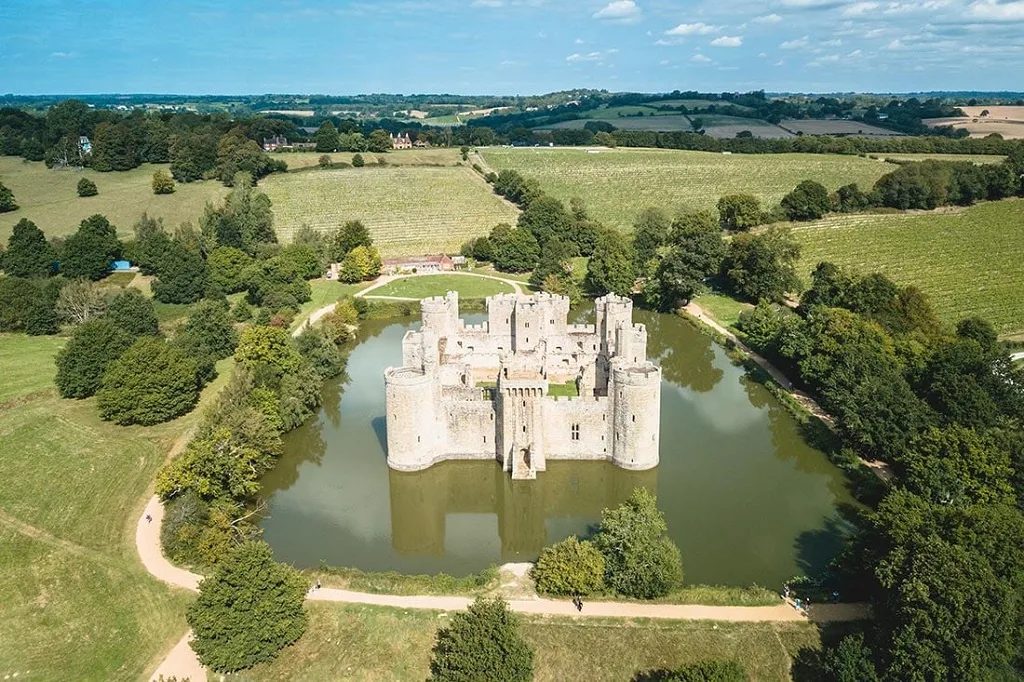
Bodiam Castle: A Medieval Marvel in England
Nestled in the heart of East Sussex, England, Bodiam Castle stands as a quintessential example of medieval architecture and history. Built in 1385, this iconic structure not only offers a glimpse into the past but also serves as a testament to the strategic and aesthetic ingenuity of the Middle Ages. With its picturesque moat and well-preserved structure, Bodiam Castle attracts tourists and history enthusiasts from around the globe.
The Historical Significance of Bodiam Castle
Bodiam Castle was constructed by Sir Edward Dalyngrigge, a former knight of Edward III, ostensibly to defend the area against French invasion during the Hundred Years’ War. The strategic location of the castle, overlooking the River Rother, made it a formidable defensive structure. Despite its primary purpose as a fortress, Bodiam Castle was also designed with a touch of elegance, featuring grand living quarters and elaborate decorations that were ahead of its time. This blend of military might and domestic comfort makes Bodiam Castle a unique historical site.
Architectural Features of Bodiam Castle
Bodiam Castle’s architecture is a masterpiece of medieval design. The castle is almost perfectly rectangular, with circular towers at each corner and a large gatehouse. The surrounding moat, which remains filled with water to this day, adds both to the castle’s defense and its picturesque beauty. Inside, the layout includes a great hall, a chapel, and numerous chambers, all of which reflect the social and functional dynamics of the era. The preservation of these features allows visitors to experience a slice of medieval life.
Visiting Bodiam Castle Today
Today, Bodiam Castle is managed by the National Trust, ensuring its preservation for future generations. Visitors can explore the castle’s interior, walk along its battlements, and enjoy stunning views of the surrounding countryside. Special events, including medieval reenactments and educational tours, are regularly held to engage and educate the public about the castle’s rich history. The castle grounds also offer beautiful picnic spots, making it a perfect day out for families.
The Moat and its Role in Defense
The moat surrounding Bodiam Castle is one of its most striking features. More than just a decorative element, the moat served as a crucial line of defense, deterring invaders and protecting the castle from siege equipment. The wide expanse of water would have made any direct assault on the castle walls a challenging endeavor. Today, the moat remains an integral part of the castle’s charm, reflecting its towering walls and adding to the serene beauty of the site.

The Dalyngrigge Legacy
Sir Edward Dalyngrigge’s legacy is deeply intertwined with Bodiam Castle. As a prominent figure in 14th-century England, Dalyngrigge’s life and achievements are reflected in the castle he commissioned. His status and wealth are evident in the grandiosity of the castle’s design, which combines both defensive and residential elements. The Dalyngrigge family continued to own Bodiam Castle until the 15th century, leaving an indelible mark on the region’s history.
Preservation Efforts and Cultural Impact
Preserving Bodiam Castle has been a priority for historians and conservationists. The National Trust has undertaken extensive restoration projects to maintain the castle’s structure and historical integrity. These efforts ensure that Bodiam Castle remains a significant cultural and educational resource. Its impact extends beyond tourism; the castle serves as a symbol of England’s medieval heritage and architectural prowess, inspiring both awe and scholarly interest.
Popular articles
-
 Mont-Saint-Michel (France): the abbey island shaped by tides
Mont-Saint-Michel (France): the abbey island shaped by tidesMont-Saint-Michel is one of the most distinctive historical sites in …
-
 Depression Danakil: Ethiopia’s Fierce and Haunting Landscape
Depression Danakil: Ethiopia’s Fierce and Haunting LandscapeThe Danakil Depression in Ethiopia is often described as one …
-
 Coimbra, Portugal — A Student City Shaped by Centuries of Academic Tra...
Coimbra, Portugal — A Student City Shaped by Centuries of Academic Tra...Coimbra stands as one of Portugal’s most influential cultural and …
